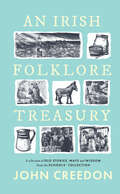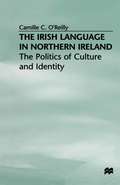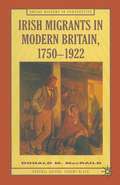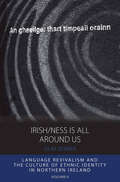- Table View
- List View
The Irish Fairy Book: Myth And Romance From The Old World (Celtic, Irish Ser.)
by Alfred Perceval Graves George DenhamLeprechauns, fairies, and other mythical figures inhabit this entertaining collection of Irish fairy lore. The rich and representative collection of 43 tales and poems includes "The Stolen Child," a beguiling poem by William Butler Yeats; "The King of the Black Desert," by poet, scholar, and statesman Douglas Hyde; Lady Jane Wilde's "The Horned Women" and "The Demon Cat," as well as works by Joseph Campbell, Jeremiah Curtin, Alfred Lord Tennyson, Patrick Kennedy, and other distinguished writers. A valuable resource for students of Celtic lore, The Irish Fairy Book offers hours of enchanted reading for lovers of folktales.
Irish Fairy Legends (Celtic, Irish Ser.)
by T. Crofton CrokerCome sit by the fire — a world of enchantment awaits you in this treasury of classic Irish stories by folklorist T. Crofton Croker. From 1812 to 1816, he roamed southern Ireland, listening to his countrymen's stories of pixies, leprechauns, and other supernatural creatures. The result is one of the first collections of Irish fairy tales on record — and it's often considered the finest. Told in plain but colorful language with charming illustrations that capture the wonder of these tales, it became an overnight bestseller. An engaging mix of darkness and humor, the thirty-eight stories are filled to the brim with Irish wit and magic. In "The Haunted Cellar," you'll meet one of Ireland's oldest families, with blood as thick as buttermilk and a reputation for hospitality. But what is the secret in Justin Mac Carthy’s wine cellar that forces every butler to quit? In "The Changeling," a new mother finds a just solution when her infant is replaced by a mischievous fairy. "The Legend of Knockfierna" teaches fearless Carroll O'Daly a hard lesson about interfering with the "little people." And that's just a taste of the delights inside. A rich reflection of Celtic culture, Irish Fairy Legends will entertain you and your family for generations.
The 'Irish' Family
by Linda ConnollyWhen situated in the wider European context, ‘the Irish family’ has undergone a process of profound transformation and rapid change in very recent decades. Recent data cites a significant increase in one parent households and a high non-marital birth rate for instance alongside the emergence of cohabitation, divorce, same sex families and reconstituted families. At the same time, the majority of children in Ireland still live in a two-parent family based on marriage and the divorce rate in Ireland is comparatively lower than other European countries. 21st century family life is, in reality, characterised by continuity and change in the Irish context. This book seeks to understand, interpret and theorise family life in Ireland by providing a detailed analysis of historical change, demographic trends, fertility and reproduction, marriage, separation and divorce, sexualities, children and young people, class, gender, motherhood, intergenerational relations, grandparents, ethnicity, globalisation, technology and family practices. A comprehensive analysis of key developments and trends over the course of the twentieth and twenty-first centuries is provided.
The 'Irish' Family
by Linda ConnollyWhen situated in the wider European context, ‘the Irish family’ has undergone a process of profound transformation and rapid change in very recent decades. Recent data cites a significant increase in one parent households and a high non-marital birth rate for instance alongside the emergence of cohabitation, divorce, same sex families and reconstituted families. At the same time, the majority of children in Ireland still live in a two-parent family based on marriage and the divorce rate in Ireland is comparatively lower than other European countries. 21st century family life is, in reality, characterised by continuity and change in the Irish context. This book seeks to understand, interpret and theorise family life in Ireland by providing a detailed analysis of historical change, demographic trends, fertility and reproduction, marriage, separation and divorce, sexualities, children and young people, class, gender, motherhood, intergenerational relations, grandparents, ethnicity, globalisation, technology and family practices. A comprehensive analysis of key developments and trends over the course of the twentieth and twenty-first centuries is provided.
Irish Feminist Futures (Transformations)
by Claire BrackenThis book is about the future: Ireland’s future and feminism’s future, approached from a moment that has recently passed. The Celtic Tiger (circa 1995-2008) was a time of extraordinary and radical change, in which Ireland’s economic, demographic, and social structures underwent significant alteration. Conceptions of the future are powerfully prevalent in women’s cultural production in the Tiger era, where it surfaces as a form of temporality that is open to surprise, change, and the unknown. Examining a range of literary and filmic texts, Irish Feminist Futures analyzes how futurity structures representations of the feminine self in women’s cultural practice. Relationally connected and affectively open, these representations of self enable sustained engagements with questions of gender, race, sexuality, and class as they pertain to the material, social, and cultural realities of Celtic Tiger Ireland. This book will appeal to students and scholars of Irish studies, Irish feminist criticism, sociology, cultural studies, literature, women's studies, gender studies, neo-materialist and feminist theories.
Irish Feminist Futures (Transformations)
by Claire BrackenThis book is about the future: Ireland’s future and feminism’s future, approached from a moment that has recently passed. The Celtic Tiger (circa 1995-2008) was a time of extraordinary and radical change, in which Ireland’s economic, demographic, and social structures underwent significant alteration. Conceptions of the future are powerfully prevalent in women’s cultural production in the Tiger era, where it surfaces as a form of temporality that is open to surprise, change, and the unknown. Examining a range of literary and filmic texts, Irish Feminist Futures analyzes how futurity structures representations of the feminine self in women’s cultural practice. Relationally connected and affectively open, these representations of self enable sustained engagements with questions of gender, race, sexuality, and class as they pertain to the material, social, and cultural realities of Celtic Tiger Ireland. This book will appeal to students and scholars of Irish studies, Irish feminist criticism, sociology, cultural studies, literature, women's studies, gender studies, neo-materialist and feminist theories.
An Irish Folkore Treasury: A Selection of Old Stories, Ways and Wisdom from the Schools' Collection
by John CreedonIn The 1930s, Irish schoolchildren were tasked with asking their oldest relatives and neighbours about stories and superstitions from times past so that ordinary people’s lives could be preserved and celebrated. What those schoolchildren wrote in their copybooks resulted in the National Folklore Archive’s Schools’ Collection, and this book contains a selection of its best stories. With chapters on ghost stories, agriculture, forgotten trades, schooling and pastimes, this is a people’s history of Ireland.There are incredible stories of self-sufficiency from an era when everything on the table was homemade. Discover how people survived on flour, milk and potatoes, and how fabric, dye, soap and candles were made by hand. There are delightful memories of childhoods spent outdoors, gathering nuts and berries, playing Tig and fishing; while stories of folk remedies reveal how wellbeing in Ireland had long been a heady potion of miraculous medals, doctors, healers, holy wells and pilgrimages.With each chapter introduced and contextualised in John Creedon’s inimitable voice, this beautiful treasury of tales is a stunning tribute to ordinary Irish people and how they lived long ago.
Irish Immigrants and Scottish Society in the Nineteenth and Twentieth Centuries: Proceedings of the Scottish Historical Studies Seminar, University of Strathclyde, 1989/90
by T M DevineThe Irish were the single largest group of immigrants to Scotland in the nineteenth and twentieth centuries, and the original settlers and their descendants have had a major impact on modern Scottish society, culture and politics. This book of original studies is the first major reassessment of the general effect of Irish immigration on Scotland since the classic works of James Handley during the 1940s. All the contributors have produced significant research in the field, and the book provides a varied and balanced insight into current historical thinking on the Irish in Scotland.
The Irish in the Victorian City (Routledge Library Editions: The Victorian World #47)
by Roger Swift; Sheridan GilleyFirst published in 1985, this book explores the social history of the Irish in Britain across a variety of cities, including Bristol, York, Glasgow, Edinburgh and Stockport. With contributions from foremost scholars in the field, it provides a thorough critical study of Irish immigration, in its social, political, cultural and religious dimensions. This book will be of interested to students of Victorian history, Irish history and the history of minorities.
The Irish in the Victorian City (Routledge Library Editions: The Victorian World)
by Roger Swift Sheridan GilleyFirst published in 1985, this book explores the social history of the Irish in Britain across a variety of cities, including Bristol, York, Glasgow, Edinburgh and Stockport. With contributions from foremost scholars in the field, it provides a thorough critical study of Irish immigration, in its social, political, cultural and religious dimensions. This book will be of interested to students of Victorian history, Irish history and the history of minorities.
The Irish in the West of Scotland 1797–1848: Trade Unions, Strikes and Political Movements
by Martin MitchellThe prevailing historical view of the Catholic Irish in the first half of nineteenth-century Scotland is that they were despised by native workers because of their religion and because most were employed as strike-breakers or low-wage labour. As a result of this hostility, the Catholic immigrants were viewed as a separate isolated community, concerned mainly with Irish and Catholic issues and unable or unwilling to participate in trade unions, strikes and radical reform movements. The Protestant Irish immigrants, on the other hand, were believed to have integrated with little difficulty, mainly because of religious, families and cultural ties with the Scots.This study presents a radically different view. It demonstrates that, whereas some Irish workers were used as a blackleg or cheap labour, others participated in trade unions and strikes alongside native workers, most notably in spinning, weaving and mining industries. The various agitations for political change in the region are analysed, revealing that the Irish – Catholic and Protestant – were significantly involved in all of them. It is also shown that Scottish reformers welcomed, and indeed actively sought, Catholic Irish participation.The campaigns for Catholic emancipation and the repeal of the Act of Union of 1800 are reviewed, as are the attitudes of the Scottish Catholic clergy to the political activities of their overwhelmingly Irish congregations.
Irish Insanity: 1800–2000 (Routledge Advances in Sociology)
by Damien BrennanThe national public asylum system in Ireland was established during the early nineteenth century and continued to operate up to the close of the twentieth century. These asylums / mental hospitals were a significant physical and social feature of Irish communities. They were used intensively and provided a convenient form of institutional intervention to manage a host of social problems. Irish Insanity identifies the long-term trends in institutional residency through the development of a detailed empirical data set, based on an analysis of original copies of the reports of Inspector of Asylums/Mental Hospitals in Ireland. Damien Brennan explores core social and historical features linked to this data including: the political context governance and social policy the relationship between church and state changing economic structures and social deprivation professionalization legislation and systems of admission and discharge categorisation and diagnostic criteria international developments family dynamics This book demonstrates that the actual rate of asylum utilisation in Ireland was the highest by international standards, but challenges the idea that an "epidemic of Irish insanity" actually existed. Offering a historical and sociological insight into an institutional legacy that is unusual within the international context, this book will be of particular relevance and interest to scholars within the fields of sociology, criminology, law, history, Irish studies, social policy, anthropology, nursing and medicine.
Irish Insanity: 1800–2000 (Routledge Advances in Sociology)
by Damien BrennanThe national public asylum system in Ireland was established during the early nineteenth century and continued to operate up to the close of the twentieth century. These asylums / mental hospitals were a significant physical and social feature of Irish communities. They were used intensively and provided a convenient form of institutional intervention to manage a host of social problems. Irish Insanity identifies the long-term trends in institutional residency through the development of a detailed empirical data set, based on an analysis of original copies of the reports of Inspector of Asylums/Mental Hospitals in Ireland. Damien Brennan explores core social and historical features linked to this data including: the political context governance and social policy the relationship between church and state changing economic structures and social deprivation professionalization legislation and systems of admission and discharge categorisation and diagnostic criteria international developments family dynamics This book demonstrates that the actual rate of asylum utilisation in Ireland was the highest by international standards, but challenges the idea that an "epidemic of Irish insanity" actually existed. Offering a historical and sociological insight into an institutional legacy that is unusual within the international context, this book will be of particular relevance and interest to scholars within the fields of sociology, criminology, law, history, Irish studies, social policy, anthropology, nursing and medicine.
The Irish Language in Northern Ireland: The Politics of Culture and Identity
by Camille C. O'ReillyA topical and authoritative investigation of the Irish language and identity in Northern Ireland. The phrase 'our own language' has come to symbolize the importance of the Irish language to Irish identity for many Nationalists in Northern Ireland. However, different interests compete to have their version of the meaning and importance of the Irish language accepted. This book investigates the role of the Irish language movement in the social construction of competing versions of Irish political and cultural identity in Northern Ireland, arguing that for some Nationalists, the Irish language has become an alternative point of political access and expression.
The Irish Medical Profession and the First World War (Medicine and Biomedical Sciences in Modern History)
by David DurninThis book examines the role of the Irish medical profession in the First World War. It assesses the extent of its involvement in the conflict while also interrogating the effect of global war on the development of Ireland’s domestic medical infrastructure, especially its hospital network. The study explores the factors that encouraged Ireland’s medical personnel to join the British Army medical services and uncovers how Irish hospital governors, in the face of increasing staff shortages and economic inflation, ensured that Ireland’s voluntary hospital network survived the war. It also considers how Ireland’s wartime doctors reintegrated into an Irish society that had experienced a profound shift in political opinion towards their involvement in the conflict and subsequently became embroiled in its own Civil War. In doing so, this book provides the first comprehensive study of the effect of the First World War on the medical profession in Ireland.
Irish Migrants in Modern Britain, 1750–1922 (Social History in Perspective)
by Donald M. MacRaildUntil the advent of 'New Commonwealth' migration in the 1950s, the Irish were by far the largest ethnic minority in Britain. This study focuses on the most important phase of Irish migration, providing an analytical discussion of why and how the Irish settled in such numbers. It examines key aspects of the social, religious and political worlds of these migrants and explains why they were so often the victims of native hostility. The book avoids the 'famine-centred' and 'big-city' focus of so many studies and demonstrates the long-run chronology and wide-ranging geography of this important migration.
Irish Migrants In Modern Wales (Liverpool University Press Ser.)
by Paul O'LearyUntil relatively recently, immigrant and ethnic minority groups were relegated to one of the silences in the history of modern Wales. Where they were mentioned at all it was as outsiders who added a dash of color and exoticism to the story of the majority but who had little to contribute to our understanding of developments in the "mainstream" of society. In recent years this picture has begun to change, and historians, sociologists, novelists and the media have all given sustained attention to the immigrant and ethnic minority experience. The essays in this volume examine the experience of Irish migrants to Wales, comparing their experience with that of other migrants and offering case studies of Irish settlement in a number of Welsh towns. Attention is also given to anti-Irish protest movements in the late nineteenth century and the later imprisonment of Irish Republicans. The essays examine in depth the social and cultural impact that Irish migrants have made on Wales, and show more broadly the ways in which the study of such migrant groups poses searching questions about the nature of society as a whole.
Irish Migrants In Modern Wales: (pdf) (Liverpool University Press Ser.)
by Paul O'LearyUntil relatively recently, immigrant and ethnic minority groups were relegated to one of the silences in the history of modern Wales. Where they were mentioned at all it was as outsiders who added a dash of color and exoticism to the story of the majority but who had little to contribute to our understanding of developments in the "mainstream" of society. In recent years this picture has begun to change, and historians, sociologists, novelists and the media have all given sustained attention to the immigrant and ethnic minority experience. The essays in this volume examine the experience of Irish migrants to Wales, comparing their experience with that of other migrants and offering case studies of Irish settlement in a number of Welsh towns. Attention is also given to anti-Irish protest movements in the late nineteenth century and the later imprisonment of Irish Republicans. The essays examine in depth the social and cultural impact that Irish migrants have made on Wales, and show more broadly the ways in which the study of such migrant groups poses searching questions about the nature of society as a whole.
Irish National Cinema (National Cinemas)
by Ruth BartonFrom the international successes of Neil Jordan and Jim Sheridan, to the smaller productions of the new generation of Irish filmmakers, this book explores questions of nationalism, gender identities, the representation of the Troubles and of Irish history as well as cinema's response to the so-called Celtic Tiger and its aftermath. Irish National Cinema argues that in order to understand the unique position of filmmaking in Ireland and the inheritance on which contemporary filmmakers draw, definitions of the Irish culture and identity must take into account the so-called Irish diaspora and engage with its cinema. An invaluable resource for students of world cinema.
Irish National Cinema (National Cinemas)
by Ruth BartonFrom the international successes of Neil Jordan and Jim Sheridan, to the smaller productions of the new generation of Irish filmmakers, this book explores questions of nationalism, gender identities, the representation of the Troubles and of Irish history as well as cinema's response to the so-called Celtic Tiger and its aftermath. Irish National Cinema argues that in order to understand the unique position of filmmaking in Ireland and the inheritance on which contemporary filmmakers draw, definitions of the Irish culture and identity must take into account the so-called Irish diaspora and engage with its cinema. An invaluable resource for students of world cinema.
Irish Nationalists and the Making of the Irish Race
by Bruce NelsonThis is a book about Irish nationalism and how Irish nationalists developed their own conception of the Irish race. Bruce Nelson begins with an exploration of the discourse of race--from the nineteenth--century belief that "race is everything" to the more recent argument that there are no races. He focuses on how English observers constructed the "native" and Catholic Irish as uncivilized and savage, and on the racialization of the Irish in the nineteenth century, especially in Britain and the United States, where Irish immigrants were often portrayed in terms that had been applied mainly to enslaved Africans and their descendants. Most of the book focuses on how the Irish created their own identity--in the context of slavery and abolition, empire, and revolution. Since the Irish were a dispersed people, this process unfolded not only in Ireland, but in the United States, Britain, Australia, South Africa, and other countries. Many nationalists were determined to repudiate anything that could interfere with the goal of building a united movement aimed at achieving full independence for Ireland. But others, including men and women who are at the heart of this study, believed that the Irish struggle must create a more inclusive sense of Irish nationhood and stand for freedom everywhere. Nelson pays close attention to this argument within Irish nationalism, and to the ways it resonated with nationalists worldwide, from India to the Caribbean.
Irish Nationalists and the Making of the Irish Race
by Bruce NelsonThis is a book about Irish nationalism and how Irish nationalists developed their own conception of the Irish race. Bruce Nelson begins with an exploration of the discourse of race--from the nineteenth--century belief that "race is everything" to the more recent argument that there are no races. He focuses on how English observers constructed the "native" and Catholic Irish as uncivilized and savage, and on the racialization of the Irish in the nineteenth century, especially in Britain and the United States, where Irish immigrants were often portrayed in terms that had been applied mainly to enslaved Africans and their descendants. Most of the book focuses on how the Irish created their own identity--in the context of slavery and abolition, empire, and revolution. Since the Irish were a dispersed people, this process unfolded not only in Ireland, but in the United States, Britain, Australia, South Africa, and other countries. Many nationalists were determined to repudiate anything that could interfere with the goal of building a united movement aimed at achieving full independence for Ireland. But others, including men and women who are at the heart of this study, believed that the Irish struggle must create a more inclusive sense of Irish nationhood and stand for freedom everywhere. Nelson pays close attention to this argument within Irish nationalism, and to the ways it resonated with nationalists worldwide, from India to the Caribbean.
An Irish Navvy – The Diary of an Exile: The Diary Of An Exile
by Donall MacAmhlaighDIrish construction workers in post-war Britain are celebrated in song and story. Donall MacAmhlaigh kept a diary as he worked the sites, danced in the Irish halls, drank in Irish pubs and lived the life of the roving Irish navvy. Work was hard, dirty and dangerous, followed by pints in the Admiral Rodney, the Shamrock, the Cattle Market Tavern and others. Living conditions were basic at best. This vivid picture of an Irish navvy's life in England in the 1950s mirrors that of an entire generation who left Ireland without education or hope. Days without food or work, the hardships of work camps, lonesome partings after trips home, periods of intense isolation and bitter reflection were all part of the experience. • Also available: Hard Road to Klondike.
Irish/ness Is All Around Us: Language Revivalism and the Culture of Ethnic Identity in Northern Ireland (Integration and Conflict Studies #6)
by Olaf ZenkerFocusing on Irish speakers in Catholic West Belfast, this ethnography on Irish language and identity explores the complexities of changing, and contradictory, senses of Irishness and shifting practices of 'Irish culture' in the domains of language, music, dance and sports. The author’s theoretical approach to ethnicity and ethnic revivals presents an expanded explanatory framework for the social (re)production of ethnicity, theorizing the mutual interrelations between representations and cultural practices regarding their combined capacity to engender ethnic revivals. Relevant not only to readers with an interest in the intricacies of the Northern Irish situation, this book also appeals to a broader readership in anthropology, sociology, cultural studies, history and political science concerned with the mechanisms behind ethnonational conflict and the politics of culture and identity in general.

















